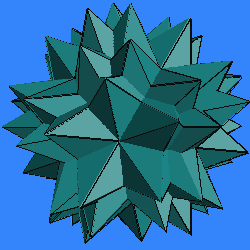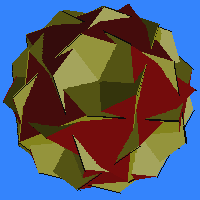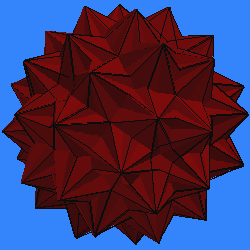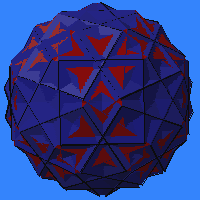Uniform Compounds of Uniform Polyhedra
 This
page discusses some of the uniform compounds. As background, read first
about compounds and compounds
of cubes. In addition, many of these can be derived by Harman's
method, which gives another perspective on them.
This
page discusses some of the uniform compounds. As background, read first
about compounds and compounds
of cubes. In addition, many of these can be derived by Harman's
method, which gives another perspective on them.
A uniform polyhedron has faces which are regular polygons and every vertex is in the same relationship to the solid. A uniform compound is a compound of identical uniform polyhedra in which every vertex is in the same relationship to the compound and no faces are completely hidden or shared between two components. This is a notion of "vertex-uniformity" as defined in the paper "Uniform Compounds of Uniform Polyhedra" by J. Skilling, cited in the references, which lists all the uniform compounds.
Dual to this is a notion of "facial uniformity," that all the faces should be in the same relationship to the solid. For example, the compound of three cubes is vertex uniform---all of its vertices are identical---while Bakos' compound of four cubes is not, since it has two different types of vertices---those which lie on 3-fold axes of symmetry and those which do not. However, Bakos' compound is facially uniform as it contains only one type of face, while the compound of three cubes has two types of faces---those orthogonal to a 2-fold axis and those orthogonal to a 4-fold axes. Taking their duals, the situation is reversed. The compound of three octahedra has two types of vertices and so it not vertex-uniform, although it is facially uniform. The compound of four octahedra is vertex uniform, but not facially uniform.
 A
few familiar compounds are both uniform and facially uniform: the 5
cubes, the 5 octahedra,
and the compounds of 2,
5, and 10
tetrahedra. Some less familiar compounds also are: three additional compounds
of tetrahedra listed below and the compounds of 2
great dodecahedra, 5
great dodecahedra, 2
small stellated dodecahedra, and 5
small stellated dodecahedra. Methods for constructing and understanding
these four were described on a previous page about compounds.
Their properties are mentioned in a paper by Anthony Smith, listed in the
references, which also gives instructions
for paper models of the last two. (The 5 great dodecahedra is illustrated
at left, and the 5 small stellated dodecahedra, at the top of this page.)
A
few familiar compounds are both uniform and facially uniform: the 5
cubes, the 5 octahedra,
and the compounds of 2,
5, and 10
tetrahedra. Some less familiar compounds also are: three additional compounds
of tetrahedra listed below and the compounds of 2
great dodecahedra, 5
great dodecahedra, 2
small stellated dodecahedra, and 5
small stellated dodecahedra. Methods for constructing and understanding
these four were described on a previous page about compounds.
Their properties are mentioned in a paper by Anthony Smith, listed in the
references, which also gives instructions
for paper models of the last two. (The 5 great dodecahedra is illustrated
at left, and the 5 small stellated dodecahedra, at the top of this page.)
Four interesting side-by-side comparisons can be made between the previous
four compounds of Kepler-Poinsot solids
and the following four, which respectively have the identical vertices
and edges: 2 icosahedra,
5 icosahedra, 2
great icosahedra, and 5
great icosahedra. These four are vertex-uniform but not facially uniform,
so their four respective duals are facially uniform, but not vertex uniform:
2 dodecahedra, 5
dodecahedra, 2
great stellated dodecahedra, and 5
great stellated dodecahedra.
 Three
uniform compounds of tetrahedra have been discussed elsewhere
(2,
5, and 10).
If the tetrahedra in those three compounds are replaced with truncated
tetrahedra, the result in all three cases is a new uniform compound of
2 truncated
tetrahedra, 5
truncated tetrahedra, and 10
truncated tetrahedra. Shown at right is one enantiomorph of the rather
attractive compound of 5.
Three
uniform compounds of tetrahedra have been discussed elsewhere
(2,
5, and 10).
If the tetrahedra in those three compounds are replaced with truncated
tetrahedra, the result in all three cases is a new uniform compound of
2 truncated
tetrahedra, 5
truncated tetrahedra, and 10
truncated tetrahedra. Shown at right is one enantiomorph of the rather
attractive compound of 5.
There are three additional uniform compounds of tetrahedra: Substituting stellae octangula for cubes in the uniform compound of three cubes results in a rigid compound of 6 tetrahedra. (Incidentally, you can stretch its components slightly to make a nice compound of six disphenoids, illustrated in Bruckner [1900].) The same substitution applied to Skilling's compound of 6 cubes gives a compound of 12 tetrahedra with rotational freedom. And finally, a compound of 6 tetrahedra is made by splitting a tetrahedron along each of its three 2-fold axes. It is one of the only two uniform compounds that have tetrahedral symmetry.
The other uniform compound with tetrahedral symmetry is this compound of 4 octahedra with rotational freedom. It can be formed by rotating the components of the rigid compound of 4 octahedra along the four tetrahedral 3-fold axes. (These are respectively dual to the compounds of 4 cubes with rotational freedom and the rigid Bakos's compound of 4 cubes.) If instead we split those four octahedra along the four 3-fold axes, we get the compound of 8 octahedra with octahedral symmetry and rotational freedom.
 In
addition to the standard compound
of five octahedra, there are four other uniform compounds of octahedra
with icosahedral symmetry. Dual to Harman's
two rigid compounds of ten cubes (version
A and version B) are the compound
of 10 octahedra version A and the compound
of 10 octahedra version B. (To remember which is which, look along
any of the ten 3-fold axes. In version A, a face of the compound orthogonal
to the axis is oriented in the same way as an imagined icosahedron face,
but in version B the octahedron face and icosahedron face are rotated relative
to each other.) Splitting the ten octahedra along the 3-fold axes (starting
from either version) gives the compound
of 20 octahedra, which in general has rotational freedom. Here is the
same compound of 20 octahedra
with a different choice of angle. However, at just the right angle,
the 120 vertices of the 20 octahedra overlap into 60 vertices with two
octahedra per vertex. This is a special rigid
compound of 20 octahedra, illustrated at left, dual to a special version
of the compound of 20 cubes which has
pairs of coplanar faces.
In
addition to the standard compound
of five octahedra, there are four other uniform compounds of octahedra
with icosahedral symmetry. Dual to Harman's
two rigid compounds of ten cubes (version
A and version B) are the compound
of 10 octahedra version A and the compound
of 10 octahedra version B. (To remember which is which, look along
any of the ten 3-fold axes. In version A, a face of the compound orthogonal
to the axis is oriented in the same way as an imagined icosahedron face,
but in version B the octahedron face and icosahedron face are rotated relative
to each other.) Splitting the ten octahedra along the 3-fold axes (starting
from either version) gives the compound
of 20 octahedra, which in general has rotational freedom. Here is the
same compound of 20 octahedra
with a different choice of angle. However, at just the right angle,
the 120 vertices of the 20 octahedra overlap into 60 vertices with two
octahedra per vertex. This is a special rigid
compound of 20 octahedra, illustrated at left, dual to a special version
of the compound of 20 cubes which has
pairs of coplanar faces.
Because the tetrahemihexahedron has the same vertices and edges as the octahedron, one can try to substitute it into the eight different compounds of octahedra just described. But the tetrahemihexahedron has only tetrahedral symmetry, and as a consequence, it turns out that only two of the results are symmetric. Both are icosahedral and chiral. Based on the standard compound of five octahedra, we get a compound of 5 tetrahemihexahedra. Based on the rigid compound of 20 octahedra, we get the compound of 20 tetrahemihexahedra. As Skilling explains, the latter is interesting mathematically for the way that the final symmetry is attained. When a 3-fold axis of a tetrahemihexahedron is aligned to a 3-fold axis of the icosahedral symmetry group, the two ends of the axis are different in that one has a face where the other has an indentation. So splitting this along the ten axes does not give a result with icosahedral symmetry. However, at just the special angle at which the 20 octahedra's vertices coincide in pairs, a vertex from a face coincides with a vertex from an indentation and symmetry is achieved.
There are eleven uniform compounds which follow from the compound of 5 cubes (or the compound of 5 octahedra) by direct substitution of another polyhedron with octahedral symmetry. Can you figure out which one is illustrated at right before finding it in the list below? It is five of which Archimedean solid ? Here is a list of these compounds, along with a single copy of the constituent in each case:
- 5 truncated cubes (one)
- 5 stellated truncated cubes (one)
- 5 cuboctahedra (one)
- 5 cubohemioctahedra (one)
- 5 octahemioctahedra (one)
- 5 rhombicuboctahedra (one)
- 5 small rhombicubes (one)
- 5 small cubicuboctahedra (one)
- 5 great cubicuboctahedra (one)
- 5 great rhombicubes (one)
- 5 great rhombicuboctahedra (one)

Finally, there are eight compounds which consist of a chiral polyhedron plus its mirror image:
- 2 snub cubes (O) (one) (dual: 2 pentagonal icositetraedra)
- 2 snub dodecahedra (I) (one) (dual: 2 pentagonal hexecontahedra, 2 color version)
- 2 great snub icosidodecahedra (I) (one) (dual: 2 great pentagonal hexecontahedra)
- 2 great inverted snub icosidodecahedra (I) (one) (dual: 2 great inverted pentagonal hexecontahedra)
- 2 great retrosnub icosidodecahedra (I) (one) (dual: 2 great pentagrammic hexecontahedra)
- 2 snub dodecadodecahedra (I) (one) (dual: 2 medial pentagonal hexecontahedra)
- 2 inverted snub dodecadodecahedra (I) (one) (dual: 2 medial inverted pentagonal hexecontahedra)
- 2 snub icosidodecadodecahedra (I) (one) (dual: 2 medial hexagonal hexecontahedra)
Here is a list of all the uniform
compounds and their duals.
